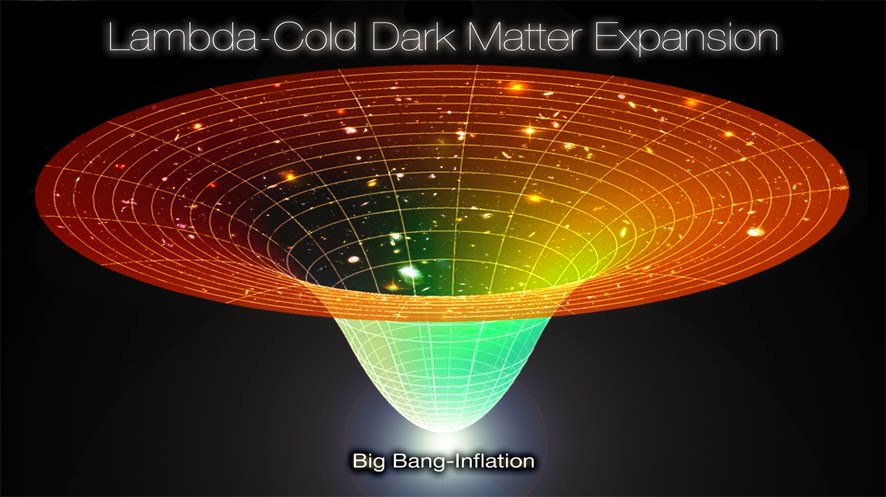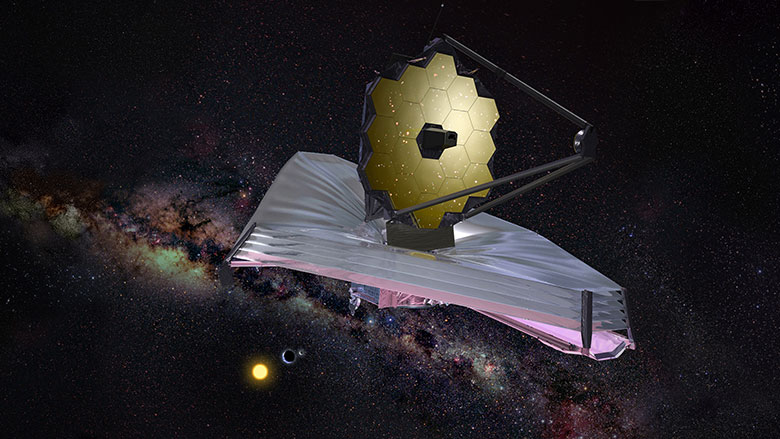Thanks to the most advanced telescopes, astronomers today can see what objects looked like 13 billion years ago, roughly 800 million years after the Big Bang. Unfortunately, they are still unable to pierce the veil of the cosmic Dark Ages, a period that lasted from 370,000 to 1 billion years after the Big Bang, where the Universe was shrowded with light-obscuring neutral hydrogen. Because of this, our telescopes cannot see when the first stars and galaxies formed – ca., 100 to 500 million years after the Big Bang.
This period is known as the Cosmic Dawn and represents the “final frontier” of cosmological surveys to astronomers. This November, NASA’s next-generation James Webb Space Telescope (JWST) will finally launch to space. Thanks to its sensitivity and advanced infrared optics, Webb will be the first observatory capable of witnessing the birth of galaxies. According to a new study from the Université de Genève, Switzerland, the ability to see the Cosmic Dawn will provide answers to today’s greatest cosmological mysteries.
The research was led by Dr. Hamsa Padmanabhan, a theoretical physicist and Collaboratrice Scientifique II at the Université de Genève. She is also the principal investigator of the Swiss National Science Foundation (SNSF) and a recipient of the 2017 Ambizione Grant (research funding awarded by the SNSF) for her independent project, titled “Probing the Universe: through reionization and beyond.”

For today’s astronomers and cosmologists, the ability to observe the Cosmic Dawn represents an opportunity to answer the most enduring cosmic mysteries. While the earliest light in the Universe is still visible today as the Cosmic Microwave Background (CMB), what followed shortly thereafter (and until about 1 billion years after the Big Bang) has historically been invisible to our most advanced instruments.
This has kept scientific minds in the dark (no pun!) on several important cosmological matters. Not only did the first stars and galaxies form during the “Dark Ages,” gradually bringing light to Universe, it was also around this time that “Cosmic Reionization” occurred. This transition period is when nearly all the neutral gas that permeated the Universe is believed to have turned into protons and electrons (aka. baryons) that make up all “normal” matter.
Unfortunately, astronomers have been unable to study this period of cosmic history. Much of the problem stems from how light from this epoch has been redshifted to the point where it is visible in a part of the radio spectrum that is inaccessible to modern-day instruments (the 21-cm transition line). But as Dr. Padmanabhan explained to Universe Today via email, this isn’t the only barrier to studying the early Universe:
“This period has eluded us so far in observations due to the high level of sensitivity required to make a detection of the emission, combined with the challenge of detecting the extremely faint signal (which comes from the hydrogen gas present in the early Universe) in the presence of foreground emission (mostly from our own galaxy) which is about 4-5 orders of magnitude larger than the signal we want to measure.”

By studying the earliest stars and galaxies in formation, astronomers will be able to see where 90% of baryonic (aka. “luminous” or “normal”) matter in the Universe came from and how it evolved into the large-scale cosmic structures we see today. The ability to model how the Universe evolved from this period until today also presents the opportunity to see the influence of Dark Matter and Dark Energy directly.
From this, scientists will evaluate different cosmological models, the most widely accepted of which is the Lambda-Cold Dark Matter (LCDM) model. Said Dr. Padmanabhan:
“Access to this epoch also represents a huge leap in our cosmological information content. This is because it contains at least 10000-100000 times more information than is available at present from all our galaxy surveys so far, as well as what we get from the Cosmic Microwave Background (CMB) radiation. It is essentially the biggest dataset we could ever hope to have for testing our models of physics! We can explore a suite of fascinating physics models beyond our standard model of cosmology.”
These include models that involve non-standard versions of Dark Matter (i.e., “warm Dark Matter”), modified versions of gravity, and inflation theories that don’t involve Dark Energy – Modified Newtonian Dynamics (MOND). Essentially, scientists will be able to see gravity and cosmic expansion from the very moment when it all began (a few trillionths of a second after the Big Bang). For years, the astronomical community has eagerly waited for the day when the James Webb would finally launch to space.

Much of their excitement stems from the fact that the observatory’s advanced infrared optics and high sensitivity will allow it to observe the earliest galaxies while they were still in formation. Ordinarily, the light from the galaxies would be obscured by all the interstellar and intergalactic dust and gas that lies between them and Earth. Along with existing and next-generation instruments, says Dr. Padmanabhan, these galaxies will be observable for the first time:
“Missions like the JWST will be able to detect extremely faint galaxies which formed when the Universe was only a tenth of its present size. Combined with radio surveys like the [Square Kilometer Array] SKA, this will provide us with a comprehensive picture of the first luminous sources and their development over cosmic time. JWST provides deep, ‘pencil-beam’-like surveys whose total field of view is of the order of several square arcminutes, so it will not access cosmological scales, but will significantly enhance our understanding of the physical processes that contributed to reionization.”
“The ALMA now routinely detects galaxies in their submillimetre line emission, such as singly ionized carbon, [CII] and doubly ionized oxygen, [OIII], both of which are very interesting probes of reionization. The forthcoming COMAP-Epoch of Reionization experiment which I am a part of plans to access carbon monoxide (CO) line emission around the middle to end stages of reionization, which is an excellent tracer of star formation. Foregrounds are not as serious of a problem for the submillimetre lines.”
This is known as the multi-messenger approach, where light signals from different instruments and at different wavelengths are combined. When applied to the Cosmic Dawn, says Dr. Padmanabhan, this approach is the most promising tool to gain insights into the Universe. Specifically, detecting gravitational waves from the first supermassive black holes will reveal how these primordial forces of nature influenced galactic evolution.

“Combining this with the knowledge of the way the gas and galaxies evolve which we gain by electromagnetic surveys, this will provide us with a comprehensive picture of Cosmic Dawn,” she said. “It will be crucial in answering an outstanding question in cosmology and astrophysics: how did the first black holes form, and what was their contribution to reionization?”
The potential to mount multi-messenger campaigns that combine high-sensitivity infrared signals with radio signals is one of the many ways in which astronomy is progressing so rapidly. In addition to more sophisticated instruments, astronomers will also benefit from improved methods, more sophisticated machine learning techniques, and opportunities for and collaborative research.
Last but not least, the ability to combine signals from different arrays (and at different wavelengths of electromagnetic energy) has already created new opportunities for sophisticated imaging campaigns. A good example of this is the Event Horizon Telescope (EHT) project, which relies on 10 radio telescopes worldwide to gather light from SMBHs (like our own Sagittarius A*). In 2019, the EHT took the first image of an SMBH; in this case, the one located at the core M87 (the Virgo A supergiant elliptical galaxy).
The opportunity to perform bleeding-edge research will abound in the near future, and the discoveries we stand to make will be nothing short of revolutionary. While there are sure to be some hiccups along the way and more mysteries to solve, one thing is for certain: the future of astronomy will be a very exciting time!
Further Reading: arXiv

